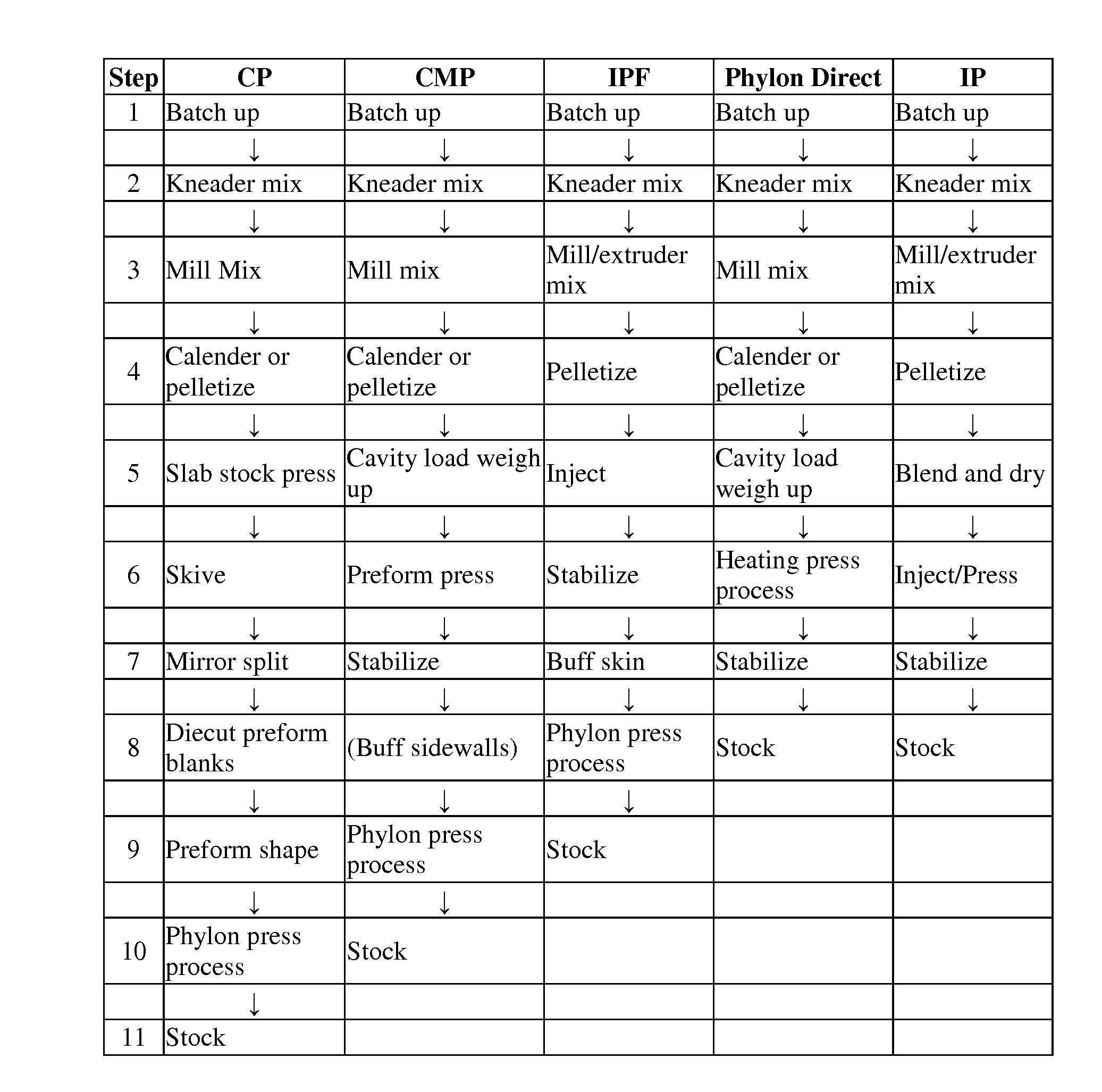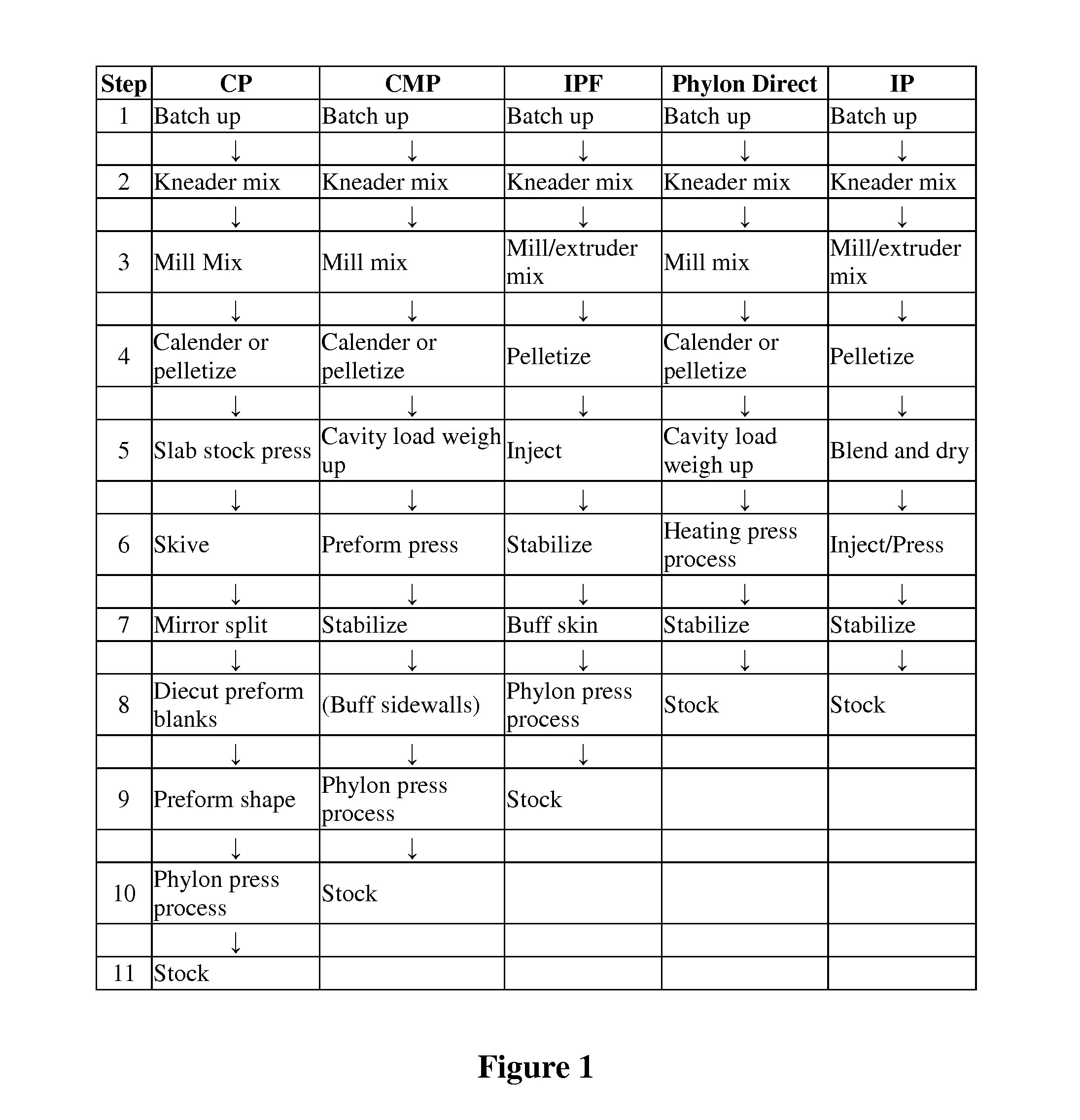Eva recycling method
a recycling method and recycling technology, applied in plastic recycling, shoes, apparel, etc., can solve the problems of generating a large amount of scrap foam, unable to simply melt blended scrap foam with virgin starting materials, and failing to lead to acceptable eva foam products, etc., to achieve the effect of increasing the physical properties of molded objects
- Summary
- Abstract
- Description
- Claims
- Application Information
AI Technical Summary
Benefits of technology
Problems solved by technology
Method used
Image
Examples
example 2
[0089]
The aim of this project is to determine the effects of 60NS on the finished surface of14% to 19% Recycled foamRecycled content0%14%19%Example no.2A2B2CEVA(21% VA)100100100CACO355560NS22St-Ac111ZnO1.51.51.5TiO25.55.55.5Blue MB0.20.20.2EVA SCRAP (use the same03030scrap for all) (use lab scrap)Azo (ADCA) - 50%101313DCP0.70.490.49Total123.9156.69158.69Foam QualityGoodGoodGoodCure temp160° C. (320 F.)160° C. (320 F.)160° C. (320 F.)Mold (mm) Starter666Time750 SEC750 SEC750 SECTest M7766Starter foam AStarter foam BStarter Foam CDurometer Asker C / Shore 00043; 44; 43; 43; 4240; 40; 40; 40; 3935; 37; 35; 35; 35Tensile (kg / cm2)28; 26; 2620; 26; 2420; 20; 17Elongation (%)277; 242; 255217; 288; 267300; 325; 267Tear (kg / cm)11; 10; 109; 9; 98; 8; 8Split tear (kg / cm)2.0; 1.82.7; 2.92.1; 2.5Specific Gravity (g / cc).16; .16; .16; .16; .16.14; .14; .14; .14;.13; .13; .13; .13;.13.13Compression set (%)60; 61; 63; 64; 6672; 71; 70; 70; 7371; 69; 74; 75; 76Resiliency (%)404040Shrinkage (%)2.7; 2.5;...
example 3
[0090]
The aim of this project is to determine the effects of 60NS on the finished surface of 14% to19% Recycled foamRecycled content0%14%19%Example no.3A3B3CEVA(21% VA)100100100CACO355560NS22St-Ac111ZnO1.51.51.5TiO25.55.55.5Blue MB0.20.20.2EVA SCRAP (use the same scrap02030for all) (use lab scrap)Azo (ADCA) - 50%101111DCP0.70.560.49Total123.9145.76156.69Foam QualityGoodGoodGoodCure temp160° C. (320 F.)160° C. (320 F.)160° C. (320 F.)Mold (mm) Starter101010Time1200 SEC1300 SEC1300 SECTest M7882Starter foam AStarter foam BStarter foam CDurometer Asker C / Measured39-4135-3829-41 / 32-36 remilledhardnessDurometer Asker C / Shore 00038; 39; 38; 39; 3833; 33; 34; 32; 3232; 34; 35; 33; 33Tensile (kg / cm2)23; 23; 2523; 23; 2421; 21; 21Elongation (%)211; 194; 198311; 293; 296441; 435; 431Tear (kg / cm)8; 7; 88; 7; 78; 9; 8Split tear (kg / cm)1.6; 1.52.0; 2.02.0; 2.3Specific Gravity (g / cc)0.14; 0.14; 0.14; 0.140.13; 0.13; 0.13; 0.130.13; 0.13; 0.13; 0.13Compression set (%)74; 79; 79; 77; 748; 77; 79; 7...
example 4
[0091]
Recycled content0%19%19%4A4B4CEVA 21%100100100CACO355560NS2Rhenosin 2602St-Ac111ZnO1.51.51.5TiO25.55.55.5Blue MB0.20.20.2EVA SCRAP (use the same03030scrap for all) (use lab scrap)Azo (-50%101010DCP0.70.490.49Total123.9155.69155.69Cure temp160° C. (320° F.)160° C. (320 F.)160° C. (320 F.)Mold (mm) Starter101010Time1200 SEC1200 SEC1200 SECTest M7663Starter foam AStarter foam BStarter foam CDurometer Asker C / Measured39-4133; 30; 30; 33; 3033; 33; 35; 33; 33hardnessDurometer Asker C / Shore 00038; 39; 38; 39; 38Tensile (kg / cm2)23; 23; 2516; 16; 1617; 17; 16Elongation (%)211; 194; 198194; 197; 188157; 165; 145Tear (kg / cm)8; 7; 86; 5; 55; 6; 5Split tear (kg / cm)1.6; 1.51.0; 1.0Specific Gravity (g / cc)0.14; 0.14; 0.14; 0.14.09; .09; .09; .09; .09.10; .10; .10; .10; .10Compression set (%)74; 79; 79; 77; 7479; 82; 75; 80; 7976; 76; 74; 73; 75Resiliency (%)404545Shrinkage (%)3.3; 3.3; 3.3; 3.31.7; 2.3; 2.1; 2.9; 2.92.9; 2.9; 2.9; 3.3; 2.3Cure Temp150° C. (305 F.)150° C. (305 F.)150° C. (305...
PUM
| Property | Measurement | Unit |
|---|---|---|
| Fraction | aaaaa | aaaaa |
| Fraction | aaaaa | aaaaa |
| Percent by mass | aaaaa | aaaaa |
Abstract
Description
Claims
Application Information
 Login to View More
Login to View More - R&D
- Intellectual Property
- Life Sciences
- Materials
- Tech Scout
- Unparalleled Data Quality
- Higher Quality Content
- 60% Fewer Hallucinations
Browse by: Latest US Patents, China's latest patents, Technical Efficacy Thesaurus, Application Domain, Technology Topic, Popular Technical Reports.
© 2025 PatSnap. All rights reserved.Legal|Privacy policy|Modern Slavery Act Transparency Statement|Sitemap|About US| Contact US: help@patsnap.com


